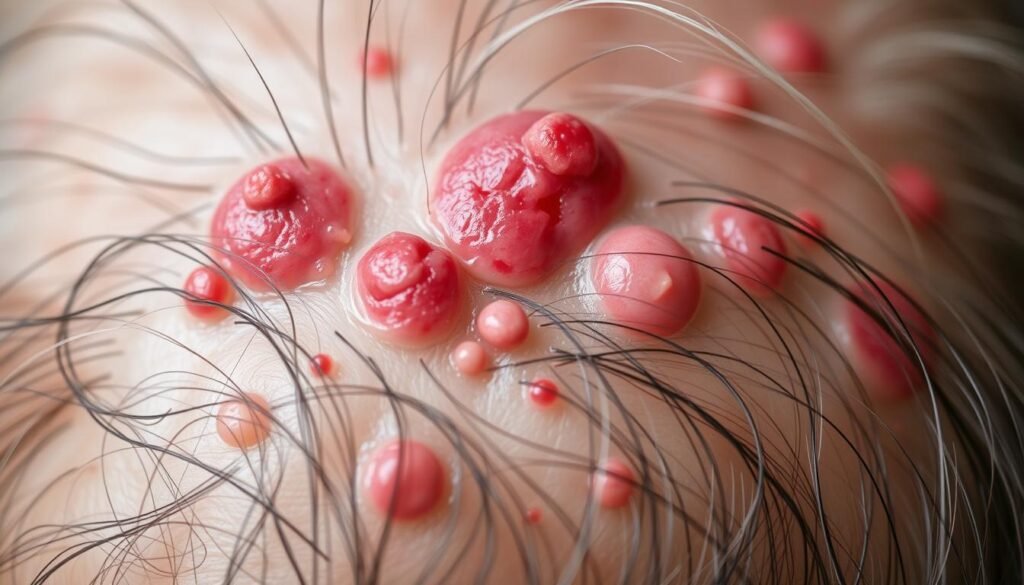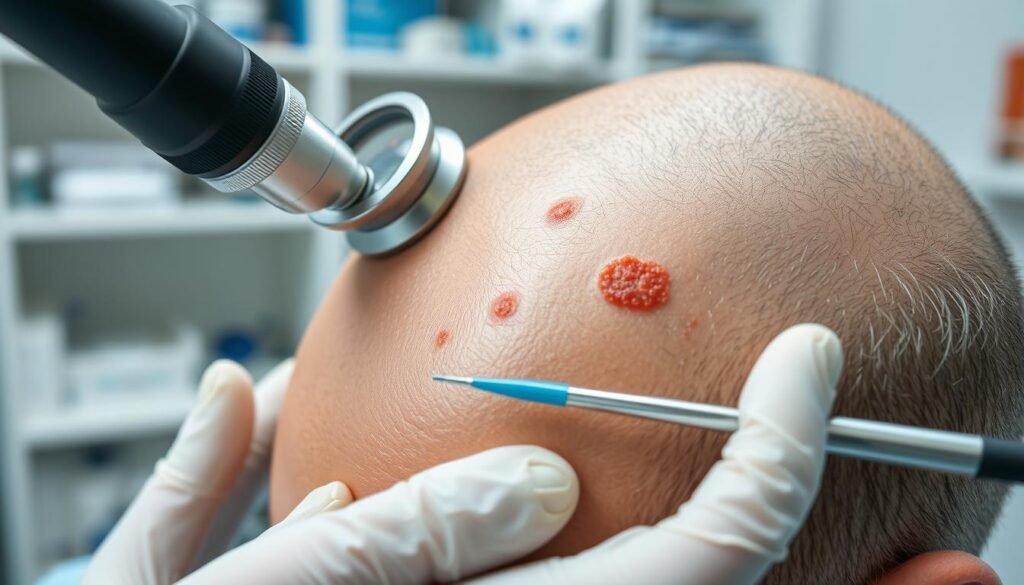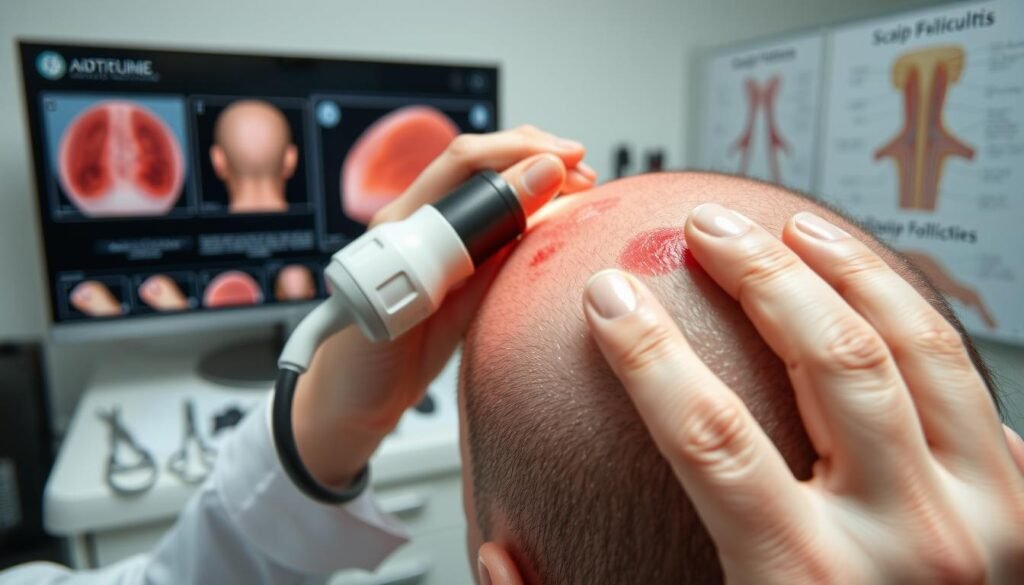Did you know about 30% of people get folliculitis at some point? This fact shows how common scalp folliculitis is. It can really affect someone’s comfort and how they look. Knowing how it’s diagnosed is key to get the right treatment. The journey to diagnose scalp folliculitis starts with a careful look by a doctor. This doc will ask about what symptoms you’ve noticed and go over your health history. Sometimes, specific scalp folliculitis tests are needed to make sure it’s folliculitis and not something else. This article will show you what steps are involved in diagnosing scalp folliculitis. It will also explain why knowing exactly what’s wrong is so important to manage it right.
Key Takeaways
- Scalp folliculitis is a common condition affecting a significant portion of the population.
- A comprehensive examination and medical history are vital for accurate diagnosis.
- Various tests may be conducted if initial treatments are ineffective.
- Medical professionals often recommend different treatments based on the type of folliculitis.
- Self-care measures can be beneficial, but seeking professional advice is crucial for persistent symptoms.
Understanding Scalp Folliculitis
Scalp folliculitis is an inflammation of hair follicles on the scalp. It can look like acne. The causes include bacteria, yeast, or blocked follicles. People might see red or swollen bumps. These can appear wherever hair grows on the scalp.
Knowing about scalp folliculitis helps understand its effects on scalp health. It also shows how it affects hair growth and looks. The discomfort can be from mild to severe. It’s important to deal with it quickly to avoid more issues.
Risk factors for scalp folliculitis include certain skin conditions, being a man with coarse or curly hair, and having a weak immune system. Some acne medications can also make it more likely. Warm compresses, antibacterial soap, and anti-dandruff shampoo can help with mild cases.
If home treatments don’t work, you might need a doctor. Signs you should see one include more redness, ongoing pain, or fever. Keeping your scalp clean is very important. Good hygiene helps control scalp folliculitis.
For more details on scalp folliculitis, including how to spot and treat it, click here.
Recognizing the Symptoms of Scalp Folliculitis
Scalp folliculitis symptoms can include red bumps on scalp that look like acne. These bumps might get inflamed, big, and may ooze pus in severe cases. People often feel an itchy scalp, leading to discomfort and irritation in daily activities.

Scalp folliculitis may also cause noticeable hair loss. This needs a doctor’s check-up. Spotting these signs early is key to prevent worse problems. If you know what to look for, you can get help fast. For more info on this, check out more information on scalp care.
Knowing different symptoms helps tell this condition apart from other skin issues. Always watch for changes. See a doctor if things don’t get better or if they get worse.
Importance of Medical History in Diagnosis
A detailed look at Scalp Folliculitis medical history is crucial for correct diagnosis. Doctors often ask about the patient’s past health to identify key factors. This helps understand what might cause the condition.
Checking past skin problems, recent hair treatments, and other health issues is vital. Things like diabetes or immune diseases can change the outcome. Knowing these helps doctors figure out who’s at risk of scalp infections.
They also talk about the patient’s age and gender, as these factors matter. For example, a study between 2010 and 2020 found that the average age for superficial folliculitis was 35. It affected both men and women. So, a full review of the patient background is important for assessments.
Using the medical history lets doctors create a treatment plan. It’s based on what the person has faced before and how they’ve reacted to treatments.
| Factors Assessed | Examples |
|---|---|
| Previous Dermatological Conditions | Previous instances of acne, eczema, or other folliculitis |
| Recent Hair Treatments | Hair dyes, straightening treatments, or chemical products |
| Underlying Health Issues | Diabetes, immune disorders, or chronic illnesses |
A focus on medical history is key for catching factors. This leads to better ways to manage scalp folliculitis.
How Is Scalp Folliculitis Diagnosed?
To diagnose scalp folliculitis, the process involves several important steps. It starts when a healthcare provider looks at your scalp. This look helps the provider see any signs of redness or infection.
Visual Examination By Healthcare Provider
During the scalp folliculitis examination, the healthcare provider checks carefully. They look for redness, swelling, or bumps filled with pus. This step is key to understanding what’s wrong.
Discussion of Symptoms and Duration
The healthcare provider also talks about your symptoms. They’ll ask about how long you’ve had them, any recent sickness, and things like medicines or where you’ve been. This talk helps figure out how serious the folliculitis is and why it happened. This makes sure you get the right treatment.

Common Tests Used for Diagnosis
Dealing with scalp folliculitis requires a careful diagnosis. Sometimes, initial checks don’t give clear answers. In these situations, doctors might use specific Scalp Folliculitis tests. These tests include checking for yeast on the skin and doing swab cultures. They figure out what kind of infection is on the scalp. This helps decide the right treatment.
Skin Scraping for Yeast Detection
A usual test is skin scraping for yeast. This test lets doctors look at skin samples through a microscope. They can find fungal elements or yeast, like those causing pityrosporum folliculitis. Finding yeast growth guides treatment towards antifungal medicine or special shampoos.
Swab Cultures to Identify Infections
Using swab cultures is another important test. This method collects samples from the skin for lab tests. It finds the exact bacteria causing the infection. Often, this bacterium is Staphylococcus aureus, a common culprit behind bacterial folliculitis. Knowing the specific pathogen lets doctors choose the best treatment.
Skin Biopsy for Ruling Out Other Conditions
Sometimes, a skin biopsy is needed to exclude other issues with similar symptoms. This involves taking a small piece of skin to look at more closely. It’s useful when other treatments haven’t worked. Or, when doctors think a more complex problem might be at play. This ensures patients get the right diagnosis and treatment for their symptoms.
| Test Type | Purpose | Common Uses |
|---|---|---|
| Skin Scraping | Detects yeast or fungal elements | Pityrosporum folliculitis |
| Swab Cultures | Identifies the specific bacteria causing the infection | Bacterial folliculitis |
| Skin Biopsy | Rules out other skin conditions | Chronic or unresponsive cases |

Procedure for Skin Scraping
The Scalp Folliculitis skin scraping procedure is key for spotting potential fungal infections. A sterile tool is used to gently take a sample from troubled spots on the scalp. The goal is to collect enough sample without hurting the skin further.
The sample then gets a close look under a microscope. This step checks for yeast and other fungal elements. It’s a big deal as it helps figure out if fungi are to blame for the scalp issues. With over forty kinds of dermatophytes that can cause skin problems, finding the right one is crucial.
Lab tests then get a deep dive into the sample, and sometimes a culture is started. These tests can take up to three weeks, but usually, if fungi are found, it’s within one to two weeks. It’s important to note, though, that not finding fungi right away doesn’t mean they aren’t there. Collecting and testing the sample can be tricky.
After the Scalp Folliculitis skin scraping, the care team talks over the results with the patient. They decide on the next steps together, based on what they’ve found. Teamwork at this stage is crucial for tackling scalp issues effectively.
| Step | Description |
|---|---|
| 1. Sample Collection | Use a sterile instrument to gently remove a sample from the affected area. |
| 2. Microscopic Examination | Analyze the sample under a microscope for signs of fungal elements. |
| 3. Culture Testing | Initiate culturing for further laboratory testing over several weeks. |
| 4. Review Findings | Discuss results and treatment options based on the laboratory analysis. |
Laboratory Evaluation of Swab Cultures
Figuring out scalp folliculitis starts with swab culture tests in the lab. A sample is taken from the sore spot and studied closely in a lab. The main aim is identifying what bug is causing trouble. Labs mostly look for bacteria, like different Staphylococcus types.
The testing process has several stages, from finding the germ to knowing its kind. These Scalp Folliculitis culture tests let doctors pick the right cure by naming the bacteria.
After the tests, doctors choose the best medicine to kill the germ. Knowing which bacteria are causing the issue is key. This helps in treating scalp folliculitis right, giving patients the care they need.
Also, these tests can clear up confusion with other scalp problems. They give clear answers about what’s causing symptoms. Seeing a doctor and getting tested is important for anyone with signs of scalp folliculitis. The right treatment comes from understanding what the tests show, which is crucial in fighting scalp folliculitis.
For more on diagnostic tests and their details, see this thorough resource.
| Test Type | Purpose |
|---|---|
| Swab Culture | Identify bacterial pathogens |
| Fungal Culture | Determine fungal causes of symptoms |
| Blood Tests | Assess for underlying conditions affecting scalp health |
| Punch Biopsy | Obtain tissue samples for refined diagnosis |
Significance of Follow-Up Appointments
Follow-up appointments are key in treating scalp folliculitis. They let healthcare pros do a detailed ongoing treatment assessment. This confirms if the treatments work well. Frequent check-ups catch problems early, like symptom returns after treatment.
At these follow-ups, patients can talk about side effects or treatment issues. This makes it easier to adjust the therapy, making care better.
The value of scalp folliculitis follow-up is huge. Keeping an eye on the patient’s progress allows for custom treatment plans. This leads to better control of the condition. Regular visits support healthy hair and boost the patient’s self-esteem.
Going to follow-up appointments is crucial for managing scalp folliculitis. It ensures the best care and great results.
Conclusion
Diagnosing scalp folliculitis takes a detailed approach. It combines clinical checks, the patient’s health history, and various tests. Knowing how to diagnose scalp folliculitis helps in getting treatment sooner. This improves patient outcomes greatly.
Being mindful of the symptoms helps people find the right treatment early. This step is crucial.
Noticing signs like redness, itchiness, and bumps is key. They can be caused by bacteria or fungi. Knowing all about your condition lets you choose the best care for your health. This leads to better scalp health and overall happiness.
We must keep our hair and scalp clean to prevent problems. Staying away from things that harm the scalp is also important. This helps keep the scalp healthy for a long time. Taking care of our scalp health is vital. It means dealing with any issues right away for a healthier future.
